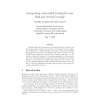Free Online Productivity Tools
i2Speak
i2Symbol
i2OCR
iTex2Img
iWeb2Print
iWeb2Shot
i2Type
iPdf2Split
iPdf2Merge
i2Bopomofo
i2Arabic
i2Style
i2Image
i2PDF
iLatex2Rtf
Sci2ools
TASE
2009
IEEE
2009
IEEE
Interpreting a Successful Testing Process: Risk and Actual Coverage
Testing is inherently incomplete; no test suite will ever be able to test all possible usage scenarios of a system. It is therefore vital to assess the implication of a system passing a test suite. This paper quantifies that implication by means of two distinct, but related, measures: the risk quantifies the confidence in a system after it passes a test suite, i.e., the number of faults still expected to be present (weighted by their severity); the actual coverage quantifies the extent to which faults have been shown absent, i.e., the fraction of possible faults that has been covered. We provide evaluation algorithms that calculate these metrics for a given test suite, as well as optimisation algorithms that yield the best test suite for a given optimisation criterion.
| Added | 21 May 2010 |
| Updated | 21 May 2010 |
| Type | Conference |
| Year | 2009 |
| Where | TASE |
| Authors | Mariëlle Stoelinga, Mark Timmer |
Comments (0)

